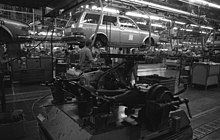Volkswagen theme by ctevans1
Download: Volkswagen_2.p3t
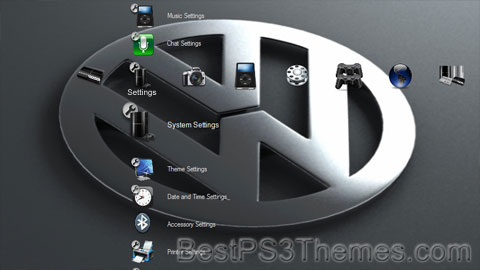
(1 background)
 | |
| Company type | Division |
|---|---|
| Industry | Automotive |
| Founded | 28 May 1937 |
| Founder | German Labour Front |
| Headquarters | , Germany |
Area served | Worldwide |
Key people | Thomas Schäfer (CEO, Volkswagen Passenger Cars) |
| Revenue | 279,232,000,000 Euro (2022) |
| 22,124,000,000 Euro (2022) | |
| 15,836,000,000 Euro (2022) | |
| Parent | Volkswagen Group |
| Website | vw.com |
Volkswagen (VW; German pronunciation: [ˈfɔlksˌvaːɡn̩] )[Note 1] is a German automobile manufacturer headquartered in Wolfsburg, Lower Saxony, Germany. Founded in 1937 by the German Labour Front under the Nazi Party and revived into the global brand it is known as today post-World War II by the British Army officer Ivan Hirst, it is known for the iconic Beetle and serves as the flagship brand of the Volkswagen Group, the largest automotive manufacturer by worldwide sales in 2016 and 2017.[1] The group's biggest market is China (including Hong Kong and Macau), which delivers 40 percent of its sales and profits.[2][3] Its name is derived from the German-language terms Volk and Wagen, translating to "people's car" when combined.
History[edit]

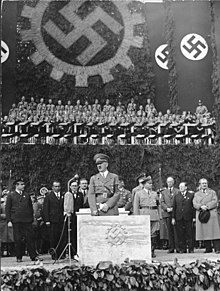
1932–1940: People's Car project[edit]
Volkswagen was established in 1937 by the German Labour Front (German: Deutsche Arbeitsfront) as part of the Strength Through Joy (German: Kraft durch Freude) program in Berlin.[4] In the early 1930s, cars were a luxury—most Germans could afford nothing more elaborate than a motorcycle, and only one German out of 50 owned a car. Seeking a potential new market, some car makers began independent "people's car" projects – the Mercedes 170H, BMW 3/15, Adler AutoBahn, Steyr 55 and Hanomag 1.3L, among others.
The growing trend was not nascent; Béla Barényi, a pioneering automotive engineer, is credited as already having conceived the basic design during the mid-1920s. Josef Ganz developed the Standard Superior (going as far as advertising it as the "German Volkswagen"). In Germany, the company Hanomag mass-produced the 2/10 PS "Kommissbrot", a small, cheap rear-engined car, from 1925 to 1928.[5] Also, in Czechoslovakia, the Hans Ledwinka-designed Tatra T77, a very popular car amongst the German elite, was becoming smaller and more affordable at each revision. Ferdinand Porsche, a well-known designer for high-end vehicles and race cars, had been trying for years to get a manufacturer interested in a small car suitable for a family. He built a car named the "Volksauto" from the ground up in 1933, using many popular ideas and several of his own, putting together a car with an air-cooled rear engine, torsion bar suspension, and a "beetle" shape, the front bonnet rounded for better aerodynamics (necessary as it had a small engine).[6]

In 1934, with many of the above projects still in development or early stages of production, Adolf Hitler became involved, ordering the production of a basic vehicle capable of transporting two adults and three children at 100 km/h (62 mph). He wanted a car every German family would be able to afford.[6] The "People's Car" would be available through a savings plan at 990 ℛ︁ℳ︁ (US$396 in 1938)—about the price of a small motorcycle (the average income being around 32 ℛ︁ℳ︁ a week).[9][10]
It soon became apparent that private industry could not turn out a car for only 990 ℛ︁ℳ︁. Thus, Hitler chose to sponsor an all-new, state-owned factory using Ferdinand Porsche's design (with some of Hitler's design suggestions, including an air-cooled engine so nothing could freeze). The intention was that German families could buy the car through a savings scheme ("Fünf Mark die Woche musst du sparen, willst du im eigenen Wagen fahren" – "Five Marks a week you must set aside, if in your own car you wish to ride"), which around 336,000 people eventually paid into.[11] However, the project was not commercially viable, and only government support was able to keep it afloat.[12][Note 2] Due to the outbreak of war in 1939, none of the participants in the savings scheme ever received a car. In 1950, a lawsuit was issued that, after 12 years of trial, ultimately provided a credit of 12% off the list price of a new VW base model or 5-times less the value paid into the saving scheme.[13]
Prototypes of the car called the KdF-Wagen (from the German term Kraft durch Freude, meaning "Strength Through Joy") appeared from 1938 onwards. The first cars had been produced in Stuttgart. The car already had its distinctive round shape and air-cooled, flat-four, rear-mounted engine. The VW car was just one of many KdF programs, which included things such as tours and outings. The prefix Volks ("People's") was not just applied to cars, but also to other products in Germany—the Volksempfänger radio receiver for instance. On 28 May 1937, Gesellschaft zur Vorbereitung des Deutschen Volkswagens mbH ("Company for the Preparation of the German Volkswagen Ltd."), or Gezuvor[14] for short, was established in Berlin by the Deutsche Arbeitsfront, the national labour organization of the Nazi Party. More than a year later, on 16 September 1938, it was renamed to Volkswagenwerk GmbH.[15][16]

Erwin Komenda, the longstanding Auto Union chief designer, part of Ferdinand Porsche's hand-picked team,[6] developed the car body of the prototype, which was recognisably the Beetle known today. It was one of the first cars designed with the aid of a wind tunnel—a method used for German aircraft design since the early 1920s. The car designs were put through rigorous tests and achieved a record-breaking million miles of testing before being deemed finished.
The construction of the new factory started in May 1938 in the new town of "Stadt des KdF-Wagens" (renamed Wolfsburg after the war), which had been purpose-built for the factory workers.[15] This factory had only produced a handful of cars by the time war started in 1939. None were actually delivered to any holder of the completed saving stamp books, though one Type 1 Cabriolet was presented to Hitler on 20 April 1944 (his 55th birthday).[15]
1939–1944: Wartime production and Nazi concentration camp labour[edit]
War changed production to military vehicles—the Type 82 Kübelwagen ("Bucket car") utility vehicle (VW's most common wartime model), and the amphibious Schwimmwagen—manufactured for German forces. One of the first foreigners to drive a Volkswagen was the American war correspondent Ernie Pyle, who had the use of a captured Volkswagen for a few days after the Allied victory in Tunisia in May 1943.[17] As was common with much of the production in Nazi Germany during the war, slave labour was utilised in the Volkswagen plant, e.g. from Arbeitsdorf concentration camp. The company would admit in 1998 that it used 15,000 slaves during the war effort. German historians estimated that 80% of Volkswagen's wartime workforce was slave labour.[18] Many of the slaves were reported to have been supplied from the concentration camps upon request from plant managers. A lawsuit was filed in 1998 by survivors for restitution for the forced labour.[19] Volkswagen would set up a voluntary restitution fund.[20]
1945–1948: British military intervention[edit]

In April 1945, KdF-Stadt and its heavily bombed factory were captured by the United States armed forces and subsequently handed over to the British, within whose occupation zone the town and factory fell. The factory was placed under the control of British Army officer Major Ivan Hirst, REME, a civilian Military Governor with the occupying forces. At first, one plan was to use it for military vehicle maintenance, and possibly dismantle and ship it to Britain. Since it had been used for military production, (though not of KdF-Wagens) and had been in Hirst's words, a "political animal" rather than a commercial enterprise—technically making it liable for destruction under the terms of the Potsdam Agreement—the equipment could have been salvaged as war reparations. Allied dismantling policy changed in late 1946 to mid-1947, though heavy industry continued to be dismantled until 1951.[citation needed]
One of the factory's wartime 'KdF-Wagen' cars had been taken to the factory for repairs and abandoned there. Hirst had it repainted green and demonstrated it to British Army headquarters. Short of light transport, in September 1945 the British Army was persuaded to place a vital order for 20,000 cars. However, production facilities had been massively disrupted, there was a refugee crisis at and around the factory, and some parts (such as carburettors) were unavailable. Hirst and his German assistant Heinrich Nordhoff (who went on to run the Wolfsburg facility after the military government ended in 1949) helped to stabilise the acute social situation while simultaneously re-establishing production. Hirst, for example, used his engineering experience to arrange the manufacture of carburettors, the original producers being effectively 'lost' in the Soviet zone.[21] The first few hundred cars went to personnel from the occupying forces, and to Australia Post. Some British service personnel were allowed to take their Beetles back to the United Kingdom when they were demobilised.[22][better source needed]
In 1986, Hirst said that factory workers were, after many years of Nazi conditioning, initially reluctant to follow his orders; to counter this, he had his military uniform brought back from Britain and wore it in the factory, after which he reported having no problems even though he was no longer a soldier at the time but a civilian member of the military government.[citation needed]
The post-war industrial plans for Germany set out rules that governed which industries Germany was allowed to retain. These rules set German car production at a maximum of 10% of 1936 car production.[23] By 1946, the factory produced 1,000 cars a month even though it was still in disrepair. Owing to roof and window damage, production had to stop when it rained, and the company had to barter new vehicles for steel for production.[24]
The car and its town changed their Second World War-era names to "Volkswagen" and "Wolfsburg" respectively, and production increased. It was still unclear what was to become of the factory. It was offered to representatives from the American, Australian, British, and French motor industries who all rejected it. After an inspection of the plant, Sir William Rootes, head of the British Rootes Group, told Hirst the project would fail within two years, and that the car "...is quite unattractive to the average motorcar buyer, is too ugly and too noisy. If you think you're going to build cars in this place, you're a bloody fool, young man."[25] The official report said: "To build the car commercially would be a completely uneconomic enterprise."[26]

Ford representatives were equally critical. In March 1948, the British offered the Volkswagen company to Ford, free of charge. Henry Ford II, the son of Edsel Ford, travelled to West Germany for discussions. Heinz Nordhoff was also present, as well as Ernest Breech, chairman of the board for Ford. Henry Ford II looked to Breech for his opinion, and Breech said, "Mr. Ford, I don't think what we're being offered here is worth a damn!"[27] Ford passed on the offer, leaving Volkswagen to rebuild itself under Nordhoff's leadership.[28]
1948–1961: Icon of post-war West Germany[edit]
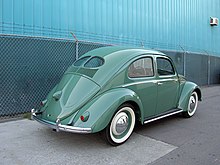
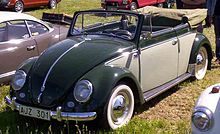
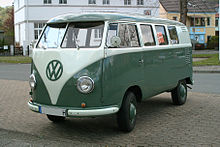


From 1948, Volkswagen became an important element, symbolically and economically, of West German regeneration.[according to whom?] Heinrich Nordhoff (1899–1968), a former senior manager at Opel who had overseen civilian and military vehicle production in the 1930s and 1940s, was recruited to run the factory in 1948. In 1949, Major Hirst left the company—now re-formed as a trust controlled by the West German government and government of the State of Lower Saxony. The "Beetle" sedan or "peoples' car" Volkswagen is the Type 1. Apart from the introduction of the Volkswagen Type 2 commercial vehicle (van, pick-up, and camper), and the VW Karmann Ghia sports car, Nordhoff pursued the one-model policy until shortly before his death in 1968.
Volkswagens were first exhibited and sold in the United States in 1949 but sold only two units in America that first year. On entry to the US market, the VW was briefly sold as a Victory Wagon. Volkswagen of America was formed in April 1955 to standardise sales and service in the United States. Production of the Type 1 Volkswagen Beetle increased dramatically over the years, the total reaching one million in 1955.
The UK's first official Volkswagen importer, Colborne Garages of Ripley, Surrey, started business with importing parts for the models brought home by soldiers returning from Germany.[22]
Canadian Motors, Limited brought in Canada's first shipment of Volkswagens on 10 July 1952 (shipping order 143075).[citation needed] The order consisted of 12 vehicles, (3) model 11C, a black, green, and sand colour (3) 11GS, a chestnut brown and two azure blue, (2) 24A-M51 in red, (1) 21A in blue, (1) 23A in blue, (1) 22A beige colour, and one ambulance.[citation needed] Volkswagens were seen in Canada for the first time at the Canadian National Exhibition in August 1952 and were accepted enthusiastically. (At least one Type 2 bus from this order still exists, and is currently in France undergoing restoration).[citation needed] The first shipment for Volkswagen Canada reached Toronto in early December 1952. (At least one Type 1 from this first shipment still exists, and was driven on a nationwide tour for Volkswagen Canada's 60th year of business festivities in 2012).[citation needed]
By 1955, sales warranted the building of the Volkswagen plant on a 32-acre (13 ha) site on Scarborough's Golden Mile. To this, a 60,000-square-foot (5,600 m2) building with administration, showrooms, service, repairs and parts was built in 1957, with storage for $4,000,000 of parts.[citation needed]
In 1959, VW started production at a plant near São Paulo in Brazil.[29] Volkswagen do Brasil was accused of spying on workers during the time of the military dictatorship in the 1970s and informing police on oppositional activities. In 1976, mass arrests occurred and some VW employees were tortured. In 1979, Brazilian VW workers travelled to Wolfsburg to inform the CEO in person. In 2015, activists and former VW employees in Brazil spoke out in public accused the company's silence about the persecution of its workers. In fall 2016, VW commissioned an expert review of the situation due end of 2017.[30]
On 22 August 1960, Volkswagenwerk GmbH was renamed to Volkswagenwerk AG. Sales soared throughout the 1960s, peaking at the end of the decade thanks in part to the famous advertising campaigns by New York advertising agency Doyle, Dane Bernbach.[citation needed] Led by art director Helmut Krone, and copywriters Julian Koenig and Bob Levinson, Volkswagen advertisements became[when?] as popular as the car, using crisp layouts and witty copy to lure the younger, sophisticated consumers with whom the car became associated.[citation needed] Even though it was almost universally known as the Beetle (or the Bug), it was never officially labelled as such by the manufacturer, instead referred to as the Type 1.[31]
Although the car was becoming outdated, during the 1960s and early 1970s, American exports, innovative advertising, and a growing reputation for reliability helped production figures surpass the levels of the previous record-holder, the Ford Model T. On 17 February 1972, the 15,007,034th Beetle was sold. Volkswagen could now claim the world production record for the most-produced, single make of car in history. By 1973, total production was over 16 million.
To commemorate its passing the Ford Model T's record sales mark and its victories in the Baja 1000 Mexican races from 1967 to 1971, Volkswagen produced its first limited-edition Beetle. It was marketed as the "Baja Champion SE"[32] in the United States and the "Marathon" Superbeetle in the rest of the world. It featured unique "Marathon Blau" metallic blue paint, steel-pressed 10-spoke 15-inch (38 cm) magnesium-alloy wheels, a commemorative metal plate mounted on the glovebox and a certificate of authenticity presented to the original purchaser. Dealer-installed options for this limited-edition Superbeetle included the following: white stripes running the length of the rocker-panel, a special shifter knob, bumper overriders, tapered exhaust tips, fake walnut inserts in the dashboard (behind the steering wheel and the glovebox cover) as well as Bosch fog lights mounted on the front bumper.[citation needed]
1961–1973: Beetle to Golf[edit]
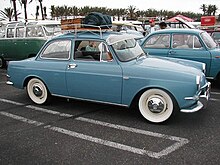
The 1961 Type 1 Beetle had a 36 hp 1200cc four cylinder air-cooled flat-four opposed OHV engine made of aluminium alloy block and heads. By 1966, the Type 1 came with a 1300cc engine. By 1967 the Type 1 had a 1500cc engine, and 1600cc in 1970. The air-cooled engine lost favour in the United States market with the advent of unleaded petrol and smog controls. These air-cooled engines were commonly tuned to be fuel-rich in order to control engine over-heating, and this led to excessive carbon monoxide emissions. VW production equipment was eventually moved to Mexico where vehicle emissions were not regulated. Beetles were popular on the US West Coast where the limited-capacity cabin heating was less inconvenient. Beetles were popularised on the US West Coast as beach buggies and dune buggies.
VW expanded its product line in 1961 with the introduction of four Type 3 models (Karmann Ghia, Notchback, Fastback, and Variant) based on the new Type 3 mechanical underpinnings. The name 'Squareback' was used in the United States for the Variant.
In 1969 the larger Type 4 (411 and 412) models were introduced. These differed substantially from previous vehicles, with the notable introduction of monocoque/unibody construction, the option of a fully automatic transmission, electronic fuel injection, and a sturdier powerplant.
In 1964, Volkswagen acquired Auto Union, and in 1969, NSU Motorenwerke AG (NSU). The former company owned the historic Audi brand, which had disappeared after the Second World War. VW ultimately merged Auto Union and NSU to create the modern Audi company, and would go on to develop it as its luxury vehicle marque. The purchase of Auto Union and NSU was a pivotal point in Volkswagen's history, as both companies yielded the technological expertise that proved necessary for VW to survive when demand for its air-cooled models went into decline.
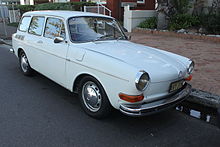
Volkswagen added a "Super Beetle"[33] (the Type 131) to its lineup in 1971. The Type 131 differed from the standard Beetle in its use of a MacPherson strut front suspension instead of the usual torsion bars. The Super Beetle featured a new hooded, padded dash and curved windshield (from 1973 model year on up). Rack and pinion steering replaced recirculating ball steering gears in the model year 1975 and up. The front of the car was stretched 2 inches (51 mm) to allow the spare tire to lie flat, and the combination of these two features increased the usable front luggage space.
In 1973, Volkswagen introduced the military-themed Type 181, or "Trekker" in Europe, "Thing" in America, recalling the wartime Type 82. The military version was produced for the NATO-era German Army during the Cold War years of 1970 to 1979. The US Thing version only sold for two years, 1973 and 1974.
